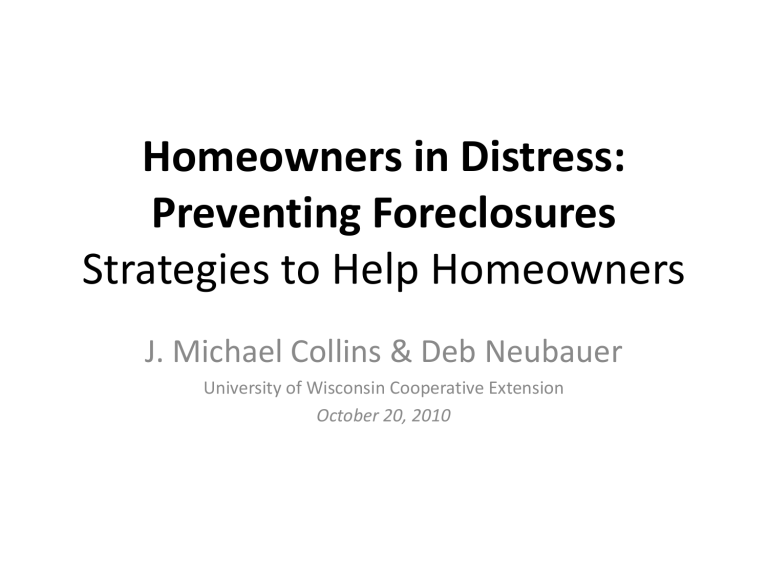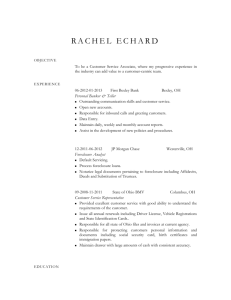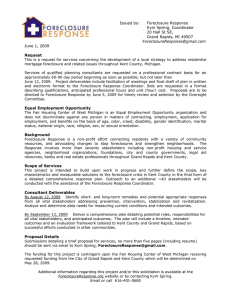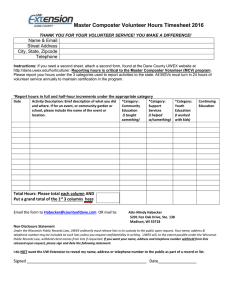Overview (presented at All Colleague Conference Oct 22, 2010)

Homeowners in Distress:
Preventing Foreclosures
Strategies to Help Homeowners
J. Michael Collins & Deb Neubauer
University of Wisconsin Cooperative Extension
October 20, 2010
Overview
• Current issues
• Data on foreclosure
• WHPE educational materials
• Strategies
• Dane County Case Study
Nationally Expecting Wave of Foreclosures Soon…
CoreLogic, formerly First American Corporation, www.corelogic.com
Distressed Sales Rising
National Home Sales by Segment
CoreLogic, formerly First American Corporation, www.corelogic.com
Who is Affected?
% Loan in REO by Demographics ( 2010)
White Black/Afr Amer Hisp/Latino Other All
7,39
6,17
3,74
4,16
2,26
White Black/Afr Amer Hisp/Latino Other All
High Area Unemployment Correlated with REOs
% REO by Zip Code Unemployment rate ( 2010)
<5% 5-10% 10-15% >15% All
11,08
5,4
5,61
4,16
1,16
<5% 5-10% 10-15% >15% All
Data for Wisconsin
• http://www.uwex.edu/ces/cced/economies/c ommunityindicators/Indicators_Links.cfm#q2_
2010
Foreclosure Filings
Adams
Ashland
Barron
Bayfield
Brown
Buffalo
Burnett
Calumet
Chippewa
Clark
Columbia
Crawford
Dane
Dodge
Door
Douglas
Dunn
Eau Claire
Florence
Fon du Lac
Forest
Grant
Green
Green Lake
Iowa
Iron
Jackson
Jefferson
Juneau
Kenosha
Kewaunee
La Crosse
Lafayette
Langlade
Lincoln
2010 (thru June)
90
33
107
35
597
10
83
82
145
69
172
43
801
232
50
82
43
69
16
72
115
99
172
11
188
18
36
209
84
628
46
156
33
60
57
2009
72
399
193
1238
95
339
78
105
142
101
164
101
101
33
143
224
197
335
16
449
37
171
57
227
67
1097
44
139
160
272
126
349
58
1550
446
Filings by County
Manitowoc
Marathon
Marinette
Marquette
Menominee
Milwaukee
Monroe
Oconto
Oneida
Outagamie
Ozaukee
Pepin
Pierce
Polk
Portage
Price
Racine
Richland
Rock
Rusk
Sauk
Sawyer
Shawano
Sheboygan
St. Croix
Taylor
Trempealeau
Vernon
Vilas
Walworth
Washburn
Washington
Waukesha
Waupaca
Waushara
Winnebago
Wood
Wisconsin (sans Portage)
2010 (thru June)
179
283
114
51
0
3071
88
125
115
417
124
18
121
180
270
783
160
79
382
118
14341
32
47
85
404
57
33
630
45
532
37
176
59
114
278
353
38
2009
6323
188
261
232
770
266
37
254
408
301
505
260
113
6
0
64
1221
64
1165
62
381
122
213
547
753
78
552
1335
338
158
787
259
27967
100
81
159
726
118
Common Themes of Interviews with
People in Foreclosure Process
• School aged kids – minimize disruption
• Relationship issues
• Pride management with family & peers
• Lack of trust in institutions
– Some exceptions for ‘helpful’ counselors / agencies
• Communication / Education is challenge
– Lack internet, limited phone, time constrained
– Interest in budgeting (reformed spendthrifts)
Financially Strapped
“I am on unemployment and I am about ready to declare bankruptcy. I can’t do consumer credit counseling b/c I am not employed. All my unemployment checks go toward paying my two mortgages. I am $19k in debt. I would like to save but I need to work in order to save.”
married woman in 40s
By late delinquency (180+ days)
• Tapped out family
• Cashed in / borrowed from 401k
• Austerity budgeting
Emotional Toll
“I had a job where I could work overtime when I wanted. So I bought a lot of toys (motorcycle, trucks, etc.). Then they got repossessed. I found it devastating. It was so embarrassing. Now I have one vehicle – the one that is most practical – and it is hard.
I did not realize my unemployment would be so long. I did not think it would happen to me.” – male in 50s
• Unwilling to reveal extent of needs
• Not seeking advice in community
Hard to Reach / Not Accessing
Information
“I have access to the internet through the library. I simply cannot afford it at home. There is a lot of waiting and stuff so it makes it difficult. I do have an internet account at work but limited so I can’t really do a search at work.”
- Single mother in 30s
• Reaching people – phone, mail, web – all limited
When during the month are people looking for help?
9000
8000
7000
6000
5000
4000
3000
2000
1000
0
September 2010, Referrals by Week
Week 1 Week 2 Week 3
Source: MortgageKeeper.org, September 2010 Referrals by Counselors
Week 4
Most Common: Food, Job, Utilities
Services Referred, 2009-2010
Senior Citizen
Childcare
Services
2%
Unemployment 3%
Assistance
3%
Other
7%
Home Repair
3%
Pharmaceutical
Costs
7%
Legal Services
9%
Food Assistance
Programs
19%
Job Training
18%
National Hotlines
11%
Heating/Utility
Costs
18%
Source: MortgageKeeper.org, 2009-2010 Referrals by Counselors
Typology of Consumers in Distress
(Negative Trigger Events)
• Income disruption, but potential to work
– Job loss/cutback (relocation options)
– Divorce (child support issues)
– Widow/er (may have limited work options)
• Disability
– Chronic (DI application process)
• Health crisis
– Acute or ongoing expenses (medical debt management)
• Investor (not all are speculators)
– tenant eviction issues
– subsidized units
• Small business failure (non-real estate)
– Sale / bankruptcy (special issues if farm)
• Strategic defaulters
Providing Services
• Prevention
– People not in default, but worried
• Early Intervention
– Missed 1-2 payments
• Late Intervention
– Missed 3+ payments
• Transitional Support
– Short sale or foreclosure auction
Early Intervention is the Ideal
Effects Vary Depending on When Counseling Occurs
0,2
0,15
0,1
0,05
0
-0,05
-0,1
Counseled when current Counseled at 30 days delinquent Counseled at 60 days delinquent Counseled at 90 days delinquent
Pr(Mod) Pr(REO)
Source: Collins & Schmeiser, 2010
http://fyi.uwex.edu/whpe/
WHPE Themes
• Financial Issues of Owning a Home
• Physical Issues of Owning a Home
• When Things Go Wrong
1. Budgeting Basics
The goals of this chapter are:
• Understanding your situation.
• The benefits of and process for creating a spending plan.
• To discuss financial priorities and goals and the steps needed to achieve them.
2. Making Ends Meet
The goals of this chapter are:
• Show resources that may be available.
• Understanding benefits and assistance programs, as well as tax credits.
• Address embarrassment of help seeking.
• Programs can have complicated details. Be patient and take time to learn your options.
3. Credit Management & Counseling
The goals of this chapter are:
• To overview the benefits and drawbacks of debt.
• How review a credit report.
• Understand credit scores
• Options for managing debt.
Take-away messages:
• Always keep an eye on your credit—it affects more than you think.
• Manage an economic hardship with the least damage to your credit record.
• Check your credit score.
• Bankruptcy and repayment are options but will not make your financial problems go away.
4. Understanding Default & Foreclosure
The goals of this chapter are:
• Background into how and why default and foreclosure occur.
• Alternatives to foreclosure
• The legal process of foreclosure.
Take-away messages:
• Losing your home to foreclosure is in no one’s best interest; understand your options.
• Decide if you want to stay and are committed to repaying the loan; if not look into a sale.
• Talk to your lender.
• Take time to learn details of programs and follow up on every detail; Don’t be derailed by paperwork.
• Ask for help but be careful of anyone offering a quick fix.
5. Keeping Organized
The goals of this chapter are:
• To help you embrace the benefits of being organized.
• To provide you with the tools to make smart decisions when purchasing Insurance.
• To encourage and guide you in creating your own household organizational system.
• To provide advice on which records should be kept and where.
Take-away messages:
• Paperwork matters!
• Know what to store and where to store it.
• Plan for the unexpected.
6. Maintaining Your Home
The goals of this chapter are:
• Understand the responsibilities of owning a home.
• Provide tools to help budget for repairs.
• Understand the costs and benefits of financing repairs and remodels.
Take-away messages:
• A lot goes into owning a home beyond simply choosing what color to paint the walls.
• Staying on top of home maintenance is important to save money in the long run.
• Energy efficiency and proper insurance can also save you money over time.
7. Refinancing
The goals of this chapter are:
• To illustrate the hidden costs that interest adds to a mortgage payment.
• To explain how refinancing can save homeowners money.
• To explain some of the fees associated with refinancing.
Take-away messages:
• Over the course of a loan, you will pay much more than you originally borrowed.
• Refinancing a loan can save you a lot of money on interest that you will not have to pay.
Dane County Example
• Identifying Problems
• Community Coalition
• Strategies
• Role of Cooperative Extension
Websites
• Home Ownership Preservation Foundation www.995hope.org
• Wisconsin Housing and Economic
Development Authority www.wisconsinforeclosureresource.com
Deb Neubauer
Dane County Financial Education Center
Lower Level, Suite 005
2300 S Park Street
Madison, WI 53713
(608) 261-5077
Fax: (608) 261-9727 deb.neubauer@ces.uwex.edu
For More Information: http://fec.uwex.edu
J. Michael Collins
Faculty Director, Center for Financial Security
University of Wisconsin-Madison
7401 Social Science, 1180 Observatory Drive
Madison, WI 53706
608-616-0369 jmcollins@wisc.edu
For More Information: cfs.wisc.edu




